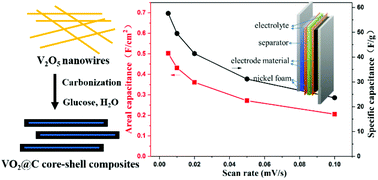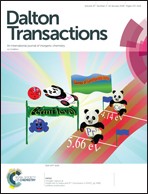Hydrothermal encapsulation of VO2(A) nanorods in amorphous carbon by carbonization of glucose for energy storage devices†
Abstract
In recent decades, tremendous attention has been paid to the development of new electrode materials with high capacitance to meet the requirements of electrode materials in supercapacitors. Among vanadium oxides, VO2(A) has recently received increasing attention due to its unique layered structure, phase transformation and applications in Li-ion batteries. However, few studies have focused on the electrochemical properties of VO2(A) as electrochemical capacitors. Herein, we develop a facile hydrothermal method to prepare VO2(A)@C core–shell structured composites by carbonization of glucose in the presence of V2O5 nanowires. The electrochemical properties of the VO2(A)@C core–shell composites are investigated as a supercapacitor electrode material for the first time; the composites show excellent pseudocapacitive behavior and display a specific capacitance as high as 179 F g−1 at 1 A g−1. A flexible asymmetric supercapacitor device is fabricated using VO2(A)@C composites and activated carbon and delivers an excellent capacitance of 0.5 F cm−2 at a scan rate of 5 mV s−1. Replacing the aqueous electrolyte with a LiCl/PVA gel electrolyte can efficiently improve the cycling performance to 85% retention after 1600 cycles. The good electrochemical performance of the composites indicates their high potential as electrode materials for supercapacitors.



 Please wait while we load your content...
Please wait while we load your content...